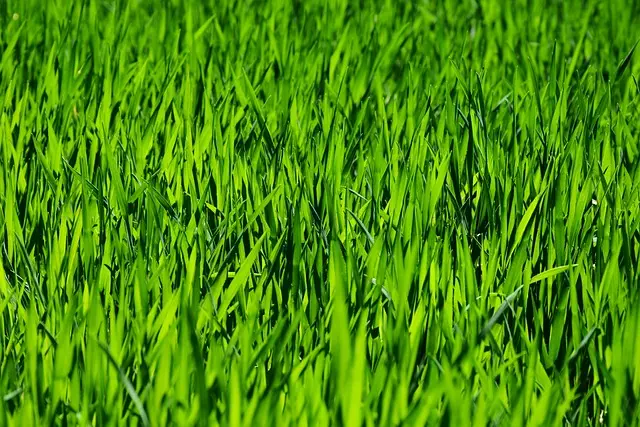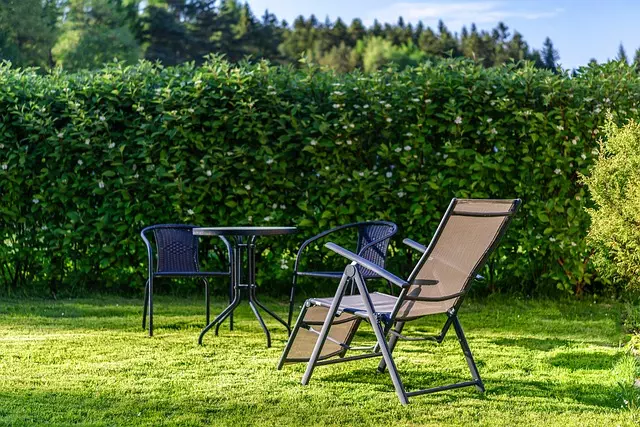Lawn Care and Landscaping are essential for maintaining a healthy, visually stunning lawn. Mulching is a key practice that conserves soil moisture, suppresses weeds, and enriches the soil over time, with various organic materials like wood chips, straw, grass clippings, and peat moss to choose from, each with its benefits. A 2-4 inch mulch layer helps regulate lawn temperature, reduce watering, and conserve water, while preventing issues like rot, soil compaction, and erosion. Edging is another vital practice that outlines the lawn's boundary, promoting a clean, well-defined separation from other landscape elements, which is not only aesthetically pleasing but also beneficial for plant health by allowing each area to thrive without encroachment. Regular mulching after precise edging ensures optimal lawn care and landscaping, resulting in a functional, lush, and visually appealing space that reflects thoughtful Lawn Care and Landscaping practices. Incorporating these techniques into your routine will lead to a resilient outdoor environment that remains healthy and attractive throughout the seasons.
healthy lawn upkeep, mulching, edging, lawn care best practices, lush greenery, landscaping, garden maintenance.
A well-manicured lawn serves as a welcoming oasis in any landscape. To achieve this, understanding the intricate balance between mulching and edging is key. This article delves into the essentials of these practices, offering insights on ‘Lawn Care and Landscaping’ that will enhance the vitality of your grass. From selecting the right type of mulch to mastering the art of edging, learn how these techniques can work synergistically to create a lawn that stands out for its vibrancy and defined boundaries. With our comprehensive guide, transform your lawn care routine into one that yields optimal results through effective mulching and edging practices.
- Understanding Mulch: Types, Benefits, and Application Strategies for Lush Lawns
- The Art of Edging: Defining Boundaries for a Manicured Lawn
- Lawn Care Essentials: Integrating Mulching with Edging for Optimal Results
- Step-by-Step Guide to Effective Mulching and Edging Routines in Lawn Maintenance
Understanding Mulch: Types, Benefits, and Application Strategies for Lush Lawns

Mulch plays a pivotal role in lawn care and landscaping, enhancing soil health and contributing to a lush lawn. It is an organic material or substance applied to the soil surface to retain moisture, suppress weeds, and improve soil structure. There are various types of mulch available, including wood chips, straw, grass clippings, and peat moss, each offering distinct benefits. Wood chips, for instance, break down slowly and add humus to the soil over time, while straw provides quick decomposition and excellent moisture retention. Incorporating the right type of mulch into your landscaping design not only aids in temperature regulation but also reduces the need for frequent watering, thus conserving water. When applying mulch, it’s important to maintain a consistent layer, typically 2-4 inches thick, around plants and along garden edges. This ensures that mulch doesn’t mound against plant stems, which could cause rot. Additionally, proper mulching can prevent soil compaction and erosion, further promoting a healthy lawn ecosystem. By understanding the types of mulch, their benefits, and optimal application strategies, homeowners can maintain lawns that are both aesthetically pleasing and resilient against various environmental challenges. Lawn care professionals often recommend mulching as part of an integrated approach to landscaping, which includes regular mowing, fertilization, and proper irrigation practices to achieve a vibrant, green lawn.
The Art of Edging: Defining Boundaries for a Manicured Lawn

The art of edging is a fundamental aspect of lawn care and landscaping that delineates the boundaries of a well-manicured lawn with precision and clarity. This meticulous process involves the physical act of cutting or laying a barrier along the perimeter of your lawn to separate it from garden beds, walkways, or other landscaping features. By doing so, edging helps to maintain a clean and distinct border that accentuates the lush greenery of the lawn while preventing grass encroachment into unwanted areas. This not only enhances the visual appeal of your outdoor space but also promotes healthier growth for both the lawn and adjacent plantings by ensuring each has its own defined area to thrive in.
When executed with care, edging becomes an almost sculptural element of lawn care and landscaping, contributing to the overall aesthetic of your property. Whether using a manual edger or a powered tool, the technique requires attention to detail and consistency along the entire length of the border. The choice between metal or plastic edging depends on factors such as durability, cost, and personal preference. Regardless of the method or materials chosen, the outcome is a sharp, clear demarcation that frames your lawn like an artist’s brushstroke, setting it apart from the surrounding environment and elevating the practice of lawn care and landscaping to an art form.
Lawn Care Essentials: Integrating Mulching with Edging for Optimal Results

Engaging in regular lawn care and landscaping practices can significantly enhance the aesthetic appeal and health of your lawn. Mulching, a practice that involves spreading a protective cover over the soil, plays a pivotal role in conserving moisture, regulating soil temperature, and suppressing weeds. When integrating mulching with edging, the benefits for your lawn are amplified. Edging demarcates the lawn from other areas of your garden or yard, creating clean lines that define the lawn’s boundary. This not only improves the visual aspect but also prevents grass from invading walkways and flowerbeds. When mulch is applied around the perimeter after edging, it acts as a complementary barrier, further inhibiting unwanted plant encroachment while maintaining an evenly moist environment for the desired turf. This combination of precise edging with thoughtful mulching promotes a healthy lawn environment by reducing maintenance time and effort, and fostering an optimal setting for grass growth. In landscaping, the synergy between these two practices leads to a well-maintained landscape that is both functional and visually pleasing, underlining the importance of a comprehensive lawn care routine. Regularly mulching after edging not only enhances the visual appeal but also contributes to the overall health of your lawn, making it a cornerstone of effective lawn care and landscaping.
Step-by-Step Guide to Effective Mulching and Edging Routines in Lawn Maintenance

Engaging in regular lawn care and landscaping practices can significantly enhance the aesthetic appeal and health of your lawn. Effective mulching and edging are fundamental aspects of a well-maintained landscape. Mulching helps to retain soil moisture, suppress weeds, and improve soil quality over time. To begin an effective mulching routine, start by removing any debris, weeds, or excess thatch from the areas you wish to mulch. Use a clean rake to smooth out the surface of the lawn before applying a two to three-inch layer of organic mulch around your plants and garden beds. Ensure that the mulch is distributed evenly to prevent moisture loss and encourage nutrient uptake by plant roots.
After mulching, edging is the next crucial step in maintaining a pristine lawn boundary. Use a half-moon edger or a spade to create a clean, distinct line between your lawn and garden beds or hardscape areas. This defined edge not only enhances the visual appeal but also prevents grass encroachment into walkways or flower beds. Regularly edging also aids in water management, as it allows for efficient irrigation of both your lawn and garden without wastage. To maintain this sharp boundary, re-edge every few weeks during active growth periods, or as needed to keep the edges neat and tidy. By integrating these mulching and edging practices into your lawn care and landscaping regimen, you’ll cultivate a healthier, more vibrant outdoor space that withstands the elements and thrives throughout the seasons.
Effective lawn care and landscaping practices play a pivotal role in achieving a verdant, well-defined lawn. This article has explored the multifaceted benefits of mulching and edging, two cornerstone techniques that enhance both the aesthetic appeal and health of your grass. By understanding the types of mulch available, their advantages, and the correct application methods, homeowners can create an optimal environment for grass growth. The art of precise edging, as detailed, not only sharpens the lawn’s boundaries but also prevents the encroachment of weeds and roots. Integrating these practices with a consistent routine ensures your lawn remains a lush, manicured oasis throughout the seasons. For those committed to mastering lawn care and landscaping, the provided guide offers clear steps to implement these techniques effectively. With this knowledge, your lawn is poised to stand out as a testament to meticulous lawn care and landscaping efforts.


